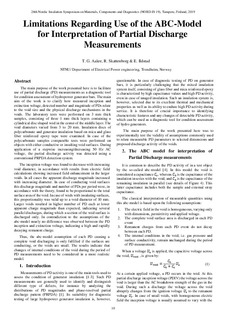| dc.contributor.author | Aakre, Torstein Grav | |
| dc.contributor.author | Skattenborg, Regina | |
| dc.contributor.author | Ildstad, Erling | |
| dc.date.accessioned | 2019-08-28T12:35:10Z | |
| dc.date.available | 2019-08-28T12:35:10Z | |
| dc.date.created | 2019-08-09T08:59:33Z | |
| dc.date.issued | 2019 | |
| dc.identifier.issn | 2535-3969 | |
| dc.identifier.uri | http://hdl.handle.net/11250/2611442 | |
| dc.description.abstract | The main purpose of the work presented here is to facilitate use of partial discharge (PD) measurements as a diagnostic tool for condition assessment of hydropower generator bars. The main aim of the work is to clarify how measured inception and extinction voltage, detected number and magnitude of PDs relate to the void size and the physical discharge mechanisms in the voids. The laboratory tests were performed on 3 mm thick samples, consisting of three 1 mm thick layers containing a cylindrical disc shaped void in the center of the middle layer. The void diameters varied from 3 to 20 mm. Insulation discs of polycarbonate and generator insulation based on mica and glass fiber reinforced epoxy tape were examined. In case of the polycarbonate samples comparable tests were performed on objects with either conductive or insulting void surfaces. During application of a stepwise increasing/decreasing 50 Hz AC voltage, the partial discharge activity was detected using a conventional PRPDA detection system. The inception voltage was found to decrease with increasing void diameter, in accordance with results from electric field calculations showing increased field enhancement in the larger voids. In all cases the apparent discharge magnitude increased with increasing diameter. In case of conducting void surfaces this discharge magnitude and number of PDs per period were, in accordance with the theory, found to be proportional to the total surface area of the void. In case of voids with insulating surfaces, this proportionality was valid up to a void diameter of 10 mm. Larger voids resulted in higher number of PD each at lower apparent charge magnitude than expected, indicating several parallel discharges, during which a section of the void surface is discharged only. In contradiction to the assumptions of the abc-model nearly no difference was observed between the PD inception and extinction voltage, indicating a high and rapidly decaying remanent charge. Thus, the abc-model assumption of each PD causing a complete void discharging is only fulfilled if the surfaces are conducting, or the voids are small. The results indicate that changes of internal conditions of the void during the period of PD measurements need to be considered in a more realistic model. | nb_NO |
| dc.language.iso | eng | nb_NO |
| dc.publisher | Nordic Insulation Symposium | nb_NO |
| dc.rights | Navngivelse 4.0 Internasjonal | * |
| dc.rights.uri | http://creativecommons.org/licenses/by/4.0/deed.no | * |
| dc.title | Limitations Regarding Use of the ABC-Model for Interpretation of Partial Discharge Measurements | nb_NO |
| dc.type | Journal article | nb_NO |
| dc.type | Peer reviewed | nb_NO |
| dc.description.version | publishedVersion | nb_NO |
| dc.source.journal | Proceedings of the Nordic Insulation Symposium | nb_NO |
| dc.identifier.doi | 10.5324/nordis.v0i26.3267 | |
| dc.identifier.cristin | 1714962 | |
| dc.description.localcode | Proceedings of the Nordic Insulation Symposium licenses all content of the journal under a Creative Commons Attribution (CC-BY) licence. | nb_NO |
| cristin.unitcode | 194,63,20,0 | |
| cristin.unitname | Institutt for elkraftteknikk | |
| cristin.ispublished | true | |
| cristin.qualitycode | 1 | |

